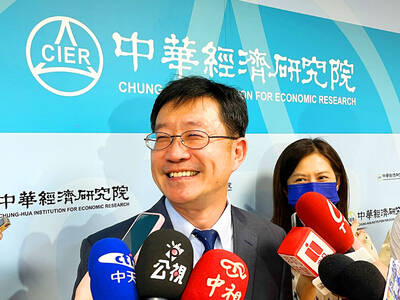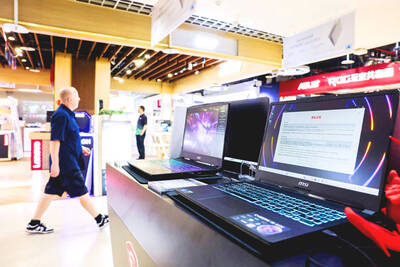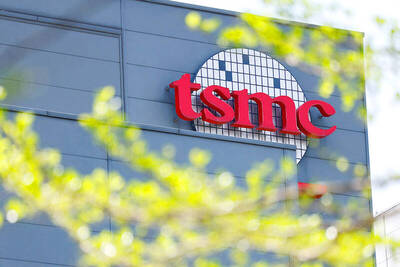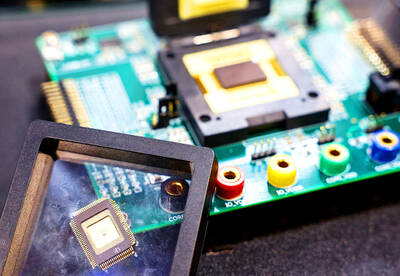Powerchip Semiconductor Corp (力晶半導體), the nation’s largest computer memory chipmaker, is pinning its hopes on an output reduction to stem persistent losses after a strategic alliance among memory chipmakers failed to solve a year-long glut that has sent chip prices falling below cash cost levels.
But analysts are skeptical that the chipmaker’s efforts would help the ailing computer memory, or dynamic random access memory (DRAM), industry, which is facing its severest slump in history.
“As the [reduction] would affect only 10 percent of the company’s [Powerchip’s] commodity DRAM output, we don’t expect investors to react strongly to this announcement,” said George Chang (張家麒), who tracks the DRAM industry for Citigroup, in a report released yesterday.
Investor doubts that the production cut could spur an industrywide recovery was reflected in DRAM stocks’ lackluster trading yesterday, although all DRAM stocks have already plunged to below their NT$10 face value.
The capacity management plan only gave a boost to Powerchip shares, which rose 1.34 percent to NT$4.55, while local rivals fell between 3.01 percent and 6.95 percent. Inotera Memories Inc (華亞科技), a memory venture between Nanya Technology and Germany Qimonda AG, posted the sharpest drop to NT$9.91.
On Monday, Powerchip chairman Frank Huang (黃崇仁) said the chipmaker planned to allocate between 10 percent and 15 percent of its computer memory capacity to manufacture other types of chips to narrow its losses. The company also urged its local peers to follow suit.
“It’s a problem of survival, not of making money,” Huang said.
He said that the latest downturn was the severest he has ever seen during his 18-year career in the DRAM industry, as prices have plunged drastically to a level at which chipmakers could not turn a profit even by using advanced 50-nanometer process technology.
The price for benchmark DRAM chips nose-dived to an all-time low of US$1.65 per unit early this month on the spot market and could drop further as slower-than-expected demand fails to ease the glut, Taipei-based researcher DRAMeXchange Technology Inc (集邦科技) said.
Stricter production management would at least bring the DRAM industry back on track faster at the expense of lower revenues, Huang said.
But Nanya Technology Corp (南亞科技), the nation’s second-biggest DRAM supplier, said yesterday it had no plans of cutting production as this could drive up its factory usage cost.
Cautious analysts like Liu Szu-liang (劉思良), a semiconductor analyst with Yuanta Securities (元大京華證券), said that production reduction might not tilt the supply-demand balance in chipmakers’ favor and was no guarantee that it could hasten the end of the year-long slump.
“Heavyweight players like Samsung Electronics Co are expanding capacity during the slowdown to force small companies to withdraw from the market,” Liu said.
In particular, companies with high inventories are under heavy pressure to survive the downturn as they continue to post massive losses given their dependence on DRAM to generate revenues, he said.
Aggregate losses by Taiwanese makers reached about NT$50 billion (US$1.6 billion) in losses in the first six months of this year.
“Besides, the latest downturn is different from the last one in 2000,” Liu said.
DRAM firms regained momentum as output dropped sharply following major consolidations, he said.
“This time, the recovery will only come after demand strongly rebounds, or companies that run out of cash are forced out of the market,” Liu said.

WEAKER ACTIVITY: The sharpest deterioration was seen in the electronics and optical components sector, with the production index falling 13.2 points to 44.5 Taiwan’s manufacturing sector last month contracted for a second consecutive month, with the purchasing managers’ index (PMI) slipping to 48, reflecting ongoing caution over trade uncertainties, the Chung-Hua Institution for Economic Research (CIER, 中華經濟研究院) said yesterday. The decline reflects growing caution among companies amid uncertainty surrounding US tariffs, semiconductor duties and automotive import levies, and it is also likely linked to fading front-loading activity, CIER president Lien Hsien-ming (連賢明) said. “Some clients have started shifting orders to Southeast Asian countries where tariff regimes are already clear,” Lien told a news conference. Firms across the supply chain are also lowering stock levels to mitigate

IN THE AIR: While most companies said they were committed to North American operations, some added that production and costs would depend on the outcome of a US trade probe Leading local contract electronics makers Wistron Corp (緯創), Quanta Computer Inc (廣達), Inventec Corp (英業達) and Compal Electronics Inc (仁寶) are to maintain their North American expansion plans, despite Washington’s 20 percent tariff on Taiwanese goods. Wistron said it has long maintained a presence in the US, while distributing production across Taiwan, North America, Southeast Asia and Europe. The company is in talks with customers to align capacity with their site preferences, a company official told the Taipei Times by telephone on Friday. The company is still in talks with clients over who would bear the tariff costs, with the outcome pending further

Six Taiwanese companies, including contract chipmaker Taiwan Semiconductor Manufacturing Co (TSMC, 台積電), made the 2025 Fortune Global 500 list of the world’s largest firms by revenue. In a report published by New York-based Fortune magazine on Tuesday, Hon Hai Precision Industry Co (鴻海精密), also known as Foxconn Technology Group (富士康科技集團), ranked highest among Taiwanese firms, placing 28th with revenue of US$213.69 billion. Up 60 spots from last year, TSMC rose to No. 126 with US$90.16 billion in revenue, followed by Quanta Computer Inc (廣達) at 348th, Pegatron Corp (和碩) at 461st, CPC Corp, Taiwan (台灣中油) at 494th and Wistron Corp (緯創) at

NEGOTIATIONS: Semiconductors play an outsized role in Taiwan’s industrial and economic development and are a major driver of the Taiwan-US trade imbalance With US President Donald Trump threatening to impose tariffs on semiconductors, Taiwan is expected to face a significant challenge, as information and communications technology (ICT) products account for more than 70 percent of its exports to the US, Chung-Hua Institution for Economic Research (CIER, 中華經濟研究院) president Lien Hsien-ming (連賢明) said on Friday. Compared with other countries, semiconductors play a disproportionately large role in Taiwan’s industrial and economic development, Lien said. As the sixth-largest contributor to the US trade deficit, Taiwan recorded a US$73.9 billion trade surplus with the US last year — up from US$47.8 billion in 2023 — driven by strong